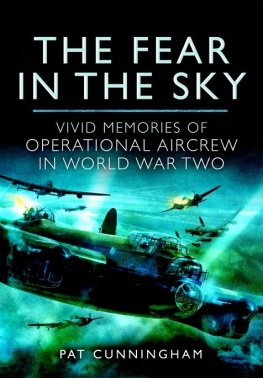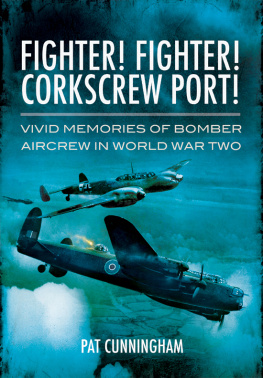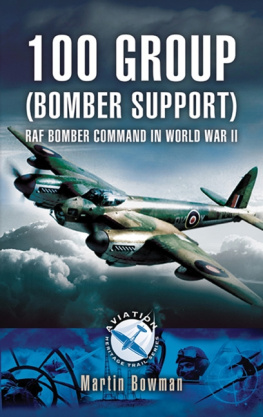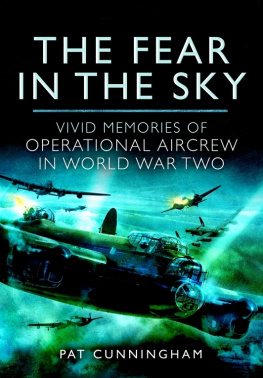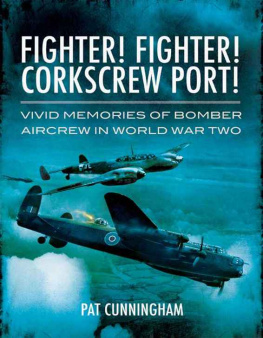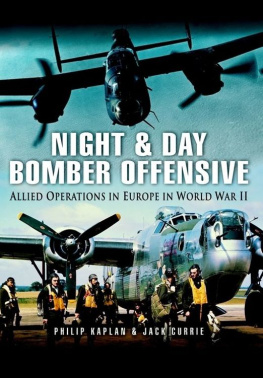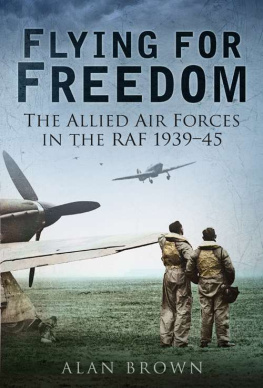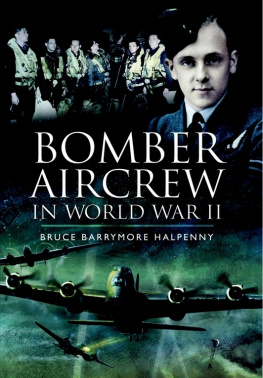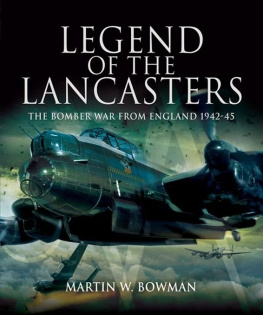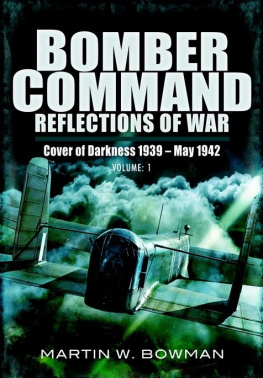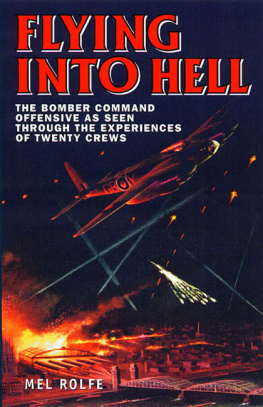Other books by the author
Non-fiction
Bomb on the Red Markers
Fighter! Fighter! Corkscrew Port!
We Kept Em Flying (pending)
Peakland Aircrashes Series:
The South (2005)
The Central Area (2006)
The North (2006)
High Peak Air Crash Sites, Central Region
White Peak Air Crash Sites
Faction
A Magnificent Diversion Series (Acclaimed by the First World War Aviation Historical Society)
The Infinite Reaches (1915 16)
Contact Patrol (1916)
Sold A Pup (1917)
The Great Disservice (1918)
Blind Faith: Joan Waste, Derbys Martyr
Joyce Lewis of Mancetter, Lichfields Feisty Martyr
Fiction
In Kinders Mists (a Kinderscout ghost story)
Though the Treason Pleases (Irish Troubles)

First published in Great Britain in 2012 by
PEN & SWORD AVIATION
an imprint of
Pen & Sword Books Ltd
47 Church Street
Barnsley
South Yorkshire
S70 2AS
Copyright Pat Cunningham 2012
9781783036301
The right of Pat Cunningham to be identified as Author of this work has been asserted by him in accordance with the Copyright, Designs and Patents Act 1988.
A CIP catalogue record for this book is available from the British Library.
All rights reserved. No part of this book may be reproduced or transmitted
in any form or by any means, electronic or mechanical including photocopying,
recording or by any information storage and retrieval system, without
permission from the Publisher in writing.
Typeset in 12/14 Palatino by Concept, Huddersfield, West Yorkshire
Printed and bound in England by
CPI Group (UK) Ltd, Croydon, CRO 4YY
Pen & Sword Books Ltd incorporates the Imprints of Pen & Sword Aviation,
Pen & Sword Family History, Pen & Sword Maritime, Pen & Sword Military,
Pen & Sword Discovery, Wharncliffe Local History, Wharncliffe True Crime,
Wharncliffe Transport, Pen & Sword Select, Pen & Sword Military Classics,
Leo Cooper, The Praetorian Press, Remember When, Seaforth Publishing
and Frontline Publishing.
For a complete list of Pen & Sword titles please contact
PEN & SWORD BOOKS LIMITED
47 Church Street, Barnsley, South Yorkshire, S70 2AS, England
E-mail: enquiries@pen-and-sword.co.uk
Website: www.pen-and-sword.co.uk
Acknowledgements
To the traced copyright holders authorizing the use of their photographs: Richard Haigh, manager, intellectual properties, Rolls-Royce; Nicola Hunt, intellectual property rights copyright unit, MOD; archives staff, Imperial War Museum; Judy Nokes, licensing adviser, HMSO (Crown Copyright/MOD); archives staff, Royal Air Force Museum.
Craving the indulgence of those for whom all contact attempts have failed.
To Julian Temple and John Lattimore of Brooklands Museum for their Wellington expertise.
To Clive Teale, aviator and grammarian, for proof-reading and technical advice. Similarly to Ken Johnson and Ken Clare for down-to-earth criticism.
To Derwent Living, winter 2010 2011 (the coldest in 100 years): for no central heating, and memorable proof-reading in fingerless gloves.
To the ever-ebullient and consistently irreverent personnel of ASDA/ Macdonalds, Spondon; Seasons Cafe, Park Farm, Derby; Croots Farm Shop, Duffield; Caudwells Mill Cafe, Rowsley; and in particular, Ellerys (Hobbs) Tea Rooms, Monsal Head.
To the National Trust staff at Kedleston Hall for both irreverence and forbearance.
To the immeasurable expedition given by Google.
Despite such inestimable assistance, any errors remaining, and all opinions expressed, are my own.
Pat Cunningham, DFM
Introduction
None of the men whose stories appear in this book feel that their wartime aircrew service made them anything out of the ordinary, even as fliers. However, from the outset, I must take issue with this self-effacing assessment. For though my 20,000 hours and forty years in Service and Civil Aviation included several officially-designated operational campaigns flown with the support of a crew, I find great difficulty in imagining my generation enduring the perils facing the wartime aircrews, still less confronting them time and time again.
From the start, the road they volunteered to follow no flier can be pressed! was neither easy nor short. For many aspirants the incentive was that, after Dunkirk and the various German blitzes on Britain, the RAF was the only way of directly hitting back at the enemy. Then again, many had been weaned on the heady appeal of Flight. However, having met the medical standards and proven themselves capable of swiftly assimilating a range of technical skills, and keen as they were to do their bit and fly against the enemy, the preparatory courses could take well over a year.
One of the greatest drawbacks to flying training was the British weather, so some would have travelled to Commonwealth countries and even to the then-neutral United States where climatic conditions afforded the all-important continuity.
The final training stage was when the various aircrew specializations came together at the Operational Training Unit where they learnt to work together as a team and to operate the type of aircraft they were to go to war in.
Most operational crews would be destined for Bomber Command but multi-crewed aircraft were employed in all other Commands as well, so that over 500 aircrew fought directly alongside the pilots who so nobly flew Hurricanes and Spitfires in the Battle of Britain; and that is not counting those who supplemented the overall effort by raiding enemy airfields and installations.
Volunteers though aircrew had to be, once they were committed to operations they were required to do a full tour of sorties against the enemy, for the most part, thirty flights, or ops. After that they would be rested for something like six months before becoming liable for a second tour. And even then this rest period was likely to be spent in instructing others; not in itself an occupation without hazard. This consideration aside, however, many crews elected to forgo their rests and continue with a second tour in the company of their tried and trusted crew, not a few referring to the bond built up on operations as being closer than kin!
Just the same, to take the case of Bomber Command, of its 125,000 aircrew only 7,000 embarked upon a second tour. There were men, though, who volunteered for a third tour. But this was rare, whereas to actually anticipate completing that third tour was to strain credulity. As it was, over 60 per cent of crews failed to return.
The hazards they faced included everything the enemy could throw against them in the way of massed and radar-directed anti-aircraft guns and high-performance day- and night-fighters. But there was also the uncertain weather and the lack of radio aids to get them down safely through fog and low cloud on their return. Notably, other than for such specialized units as some meteorological flights, there was not even an altimeter that would actually tell them their height above the ground they were overflying! And this became of vital importance if the wind had changed and they had drifted off course during their homeward flight back to a fog-draped and blacked-out near-sea-level Lincolnshire and Yorkshire base and were flying over Peaklands 2,000 foot hills.

